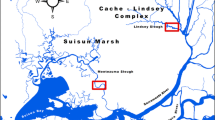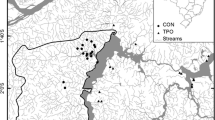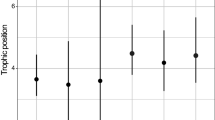Abstract
In dryland regions, increased demand for water has led to the reduction of natural aquatic habitats and threatens persisting aquatic habitats. In the Madrean Sky Islands (MSI), water demands have also resulted in the creation of novel aquatic habitats, including stock ponds. Stock ponds are important surrogate habitat for native species, yet little is known about the aquatic invertebrates utilizing these habitats. Additionally, stock ponds support non-native vertebrate predators including American bullfrogs (Lithobates catesbeiana) and Western mosquitofish (Gambusia affinis), and the effects of these predators on invertebrate communities in stock ponds are unknown. We explored similarities in invertebrate communities in stream pools and stock ponds and compared aquatic invertebrate community composition, abundance, and richness in stock ponds with and without non-native predators. We found that despite considerable functional (trait-based) overlap in aquatic invertebrate communities, a large majority (81%) of taxa were exclusive to either stock ponds or stream pools. Additionally, we observed few differences in aquatic invertebrate community composition, abundance, and richness in stock ponds with and without non-native predators. We discuss ecological implications of our observations, limitations of our approach, and the importance of future work in determining the role of stock ponds in conservation of the region’s aquatic invertebrates.




Similar content being viewed by others
References
Balfour, P. S. & S. R. Morey, 1999. Prey selection by juvenile bullfrogs in a constricted vernal pool complex. Transaction of the Western Section of the Wildlife Society 35: 34–40.
Barbour, M. T., J. Gerritsen, B. D. Snyder & J. B. Stribling, 1999. Rapid Bioassessment Protocols for Use in Streams and Wadeable Rivers: Periphyton, Benthic Macroinvertebrates and Fish (EPA 841-B-99-002), 2nd ed. U.S. Environmental Protection Agency; Office of Water, Washington, DC.
Bogan, M. T., 2012. Drought, dispersal, and community dynamics in arid-land streams. Doctoral dissertation, Oregon State University, Corvallis, OR.
Bogan, M. T. & K. S. Boersma, 2012. Aerial dispersal of aquatic invertebrates along and away from arid-land streams. Freshwater Science 31: 1131–1144.
Bogan, M. T. & D. A. Lytle, 2007. Seasonal flow variation allows ‘time-sharing’ by disparate aquatic insect communities in montane desert streams. Freshwater Biology 52: 290–304.
Bogan, M. T., O. Gutierrez-Ruacho, A. Alvarado-Castro & D. A. Lytle, 2013. Habitat type and permanence determine local aquatic invertebrate community structure in the Madrean Sky Islands. In Gottfried, G. J., P. F. Ffolliott, B. S. Gebow, L. G. Eskew & L. C. Collins (eds), Merging science and management in a rapidly changing world: Biodiversity and management of the Madrean Archipelago III and Proceedings of the 7th Conference on Research and Resource Management in the Southwestern Deserts, Tucson, AZ: 277–282.
Bonada, N., S. Dolédec & B. Statzner, 2007. Taxonomic and biological trait differences of stream macroinvertebrate communities between mediterranean and temperate regions: implications for future climatic scenarios. Global Change Biology 13: 1658–1671.
Céréghino, R., A. Ruggiero, P. Marty & S. Angélibert, 2008. Biodiversity and distribution patterns of freshwater invertebrates in farm ponds of a south-western French agricultural landscape. Hydrobiologia 597: 43–51.
Colwell, R. K. & J. A. Coddington, 1994. Estimating terrestrial biodiversity through extrapolation. Philosophical Transactions 345: 101–118.
Deacon, J. E., A. E. Williams, C. D. Williams & J. E. Williams, 2007. Fueling population growth in Las Vegas: how large-scale groundwater withdrawal could burn regional biodiversity. BioScience 57: 688–698.
Della Bella, V., M. Bazzanti & F. Chiarotti, 2005. Macroinvertebrate diversity and conservation status of Mediterranean ponds in Italy: water permanence and mesohabitat influence. Aquatic Conservation 15: 583–600.
Fischer, J. R., R. M. Krogman & M. C. Quist, 2013. Influences of native and non-native benthivorous fishes on aquatic ecosystem degradation. Hydrobiologia 711: 187–199.
Gottfried, G. J., P. F. Ffolliott, B. S. Gebow, L. G. Eskew & L. C. Collins, 2013. Merging science and management in a rapidly changing world. In Biodiversity and Management of the Madrean Archipelago III and Proceedings of the 7th Conference on Research and Resource Management in the Southwestern Deserts, 2012 May 1–5, Tucson, AZ, RMRS-P-67. Fort Collins, CO: U.S. Department of Agriculture, Forest Service, Rocky Mountain Research Station: 593 p.
Govindarajulu, P., W. S. Price & B. R. Anholt, 2006. Introduced bullfrogs (Rana catesbeiana) in western Canada: has their ecology diverged? Journal of Herpetology 40: 249–260.
Gray, L. J. & S. G. Fisher, 1981. Postflood recolonization pathways of macroinvertebrates in a lowland Sonoran Desert stream. American Midland Naturalist 106: 249–257.
Herbst, D. B., M. T. Bogan, S. K. Roll & H. D. Safford, 2012. Effects of livestock exclusion on in-stream habitat and benthic invertebrate assemblages in montane streams. Freshwater Biology 57: 204–217.
Hirai, T., 2004. Diet composition of introduced bullfrog, Rana catesbeiana, in the Mizorogaike Pond of Kyoto, Japan. Ecological Research 19: 375–380.
Holitzki, T. M., R. A. MacKenzie, T. N. Wiegner & K. J. McDermid, 2013. Differences in ecological structure, function, and native species abundance between native and invaded Hawaiian streams. Ecological Applications 23: 1367–1383.
Johnson, P. T. J., J. D. Olden & M. J. V. Zanden, 2008. Dam invaders: impoundments facilitate biological invasions in freshwaters. Frontiers in Ecology and the Environment 6: 357–363.
Jones, T. R. & R. J. Timmons, 2010. Hyla wrightorum (Arizona Treefrog). Predation. Herpetological Review 41: 473–474.
Kerr, S. 2012. Parker Canyon Lake Store. Personal Communication. Bullfrog Removal Costs.
Kuehne, L. M. & J. D. Olden, 2012. Prey naivety in the behavioural responses of juvenile Chinook (Oncorhynchus tshawytscha) salmon to an invasive predator. Freshwater Biology 57: 1126–1137.
Larned, S. T., T. Datry, D. B. Arscott & K. Tockner, 2010. Emerging concepts in temporary-river ecology. Freshwater Biology 55: 717–738.
Lawler, S. P., D. Dritz, T. Strange & M. Holyoak, 1999. Effects of introduced mosquitofish and bullfrogs on the threatened California Red-Legged Frog. Conservation Biology 13: 613–622.
Legnouo, A. E. A., M. J. Samways & J. P. Simaika, 2013. Value of Artificial Ponds for Aquatic Beetle and Bug Conservation in the Cape Floristic Region Biodiversity Hotspot. Marine and Freshwater Ecosystems, Aquatic Conservation. doi:10.1002/aqc.2413.
Letnic, M., J. K. Webb, T. S. Jessop, D. Florance & T. Dempster, 2014. Artificial water points facilitate the spread of an invasive vertebrate in arid Australia. Journal of Applied Ecology 51: 795–803.
Linden, A. L. & J. J. Cech Jr, 1990. Prey selection by mosquitofish (Gambusia affinis) in California rice fields: effect of vegetation and prey species. Journal of the American Mosquito Control Association 6: 115–120.
Lytle, D. A., 2000. Biotic and abiotic effects of flash flooding in a montane desert stream. Archiv für Hydrobiologie 150: 85–100.
Lytle, D. A., 2003. Reconstructing long-term flood regimes with rainfall data: effects of flood timing on caddisfly populations. The Southwestern Naturalist 48: 36–42.
McCarthy, J. M., C. L. Hein, J. D. Olden & M. J. V. Zanden, 2006. Coupling long-term studies with meta-analysis to investigate impacts of non-native crayfish on zoobenthic communities. Freshwater Biology 51: 224–235.
Merritt, R. W., K. W. Cummins & M. B. Berg, 2008. An Introduction to the Aquatic Insects of North America, 4th ed. Kendall/Hunt Publishing Company, Dubuque.
National Climatic Data Center, National Oceanic Atmospheric Administration (NOAA), 2014. Annual climatological summary for Sierra Vista, Arizona in 2011 and 2012 [http://www.ncdc.noaa.gov/cdo-web/search]. Accessed 06 April 2014.
Oksanen, J., F. G. Blanchet, R. Kindt, P. Legendre, P. R. Minchin, R. B. O’Hara, G. L. Simpson, P. Solymos, M. Henry, H. Stevens & H. Wagner, 2012. Vegan: community ecology package. R package version 2.0-3.
Peck, G. W. & W. E. Walton, 2008. Effect of mosquitofish (Gambusia affinis) and sestonic food abundance on the invertebrate community within a constructed treatment wetland. Freshwater Biology 53: 2220–2233.
Peltzer, P., R. Lajmanovich, A. Attademo & A. Beltzer, 2006. Diversity of anurans across agricultural ponds in Argentina. Biodiversity and Conservation 15: 3499–3513.
Poff, N. L., J. D. Olden, N. K. M. Vieira, D. S. Finn, M. P. Simmons & B. C. Kondratieff, 2006. Functional trait niches of North American lotic insects: traits-based ecological applications in light of phylogenetic relationships. Journal of the North American Benthological Society 25: 730–755. (Trait Matrix, Appendix).
Rahel, F. J. & J. D. Olden, 2008. Assessing the effects of climate change on aquatic invasive species. Conservation Biology 22: 521–533.
Rosen, P. C. & C. R. Schwalbe, 1995. Bullfrogs: introduced predators in southwestern wetlands. In LaRoe, E. T., G. S. Farris, C. E. Puckett, P. D. Doran & M. J. Mac (eds), Our Living Resources: A Report to the Nation on the Distribution, Abundance, and Health of United States Plants, Animals, and Ecosystems. Department of the Interior, National Biological Service, Washington, DC: 452–454.
Schriever, T. A., M. T. Bogan, K. S. Boersma, M. Cañedo-Argüelles, K. L. Jaeger, J. D. Olden & D. A. Lytle, 2015. Hydrology shapes taxonomic and functional structure of desert stream invertebrate communities. Freshwater Science 34(2).
Snow, N. P. & G. Witmer, 2010. American bullfrogs as invasive species: a review of the introduction, subsequent problems, management options, and future directions. In R. M. Timm & K. A. Fagerstone (eds), Proceedings of the 24th Vertebrate Pest Conference: 86–89.
Sih, A., D. I. Bolnick, B. Luttbeg, J. L. Orrock, S. D. Peacor, L. M. Pintor, E. Preisser, J. S. Rehage & J. R. Vonesh, 2010. Predator-prey naïveté, antipredator behavior, and the ecology of predator invasions. Oikos 119: 610–621.
The R Foundation for Statistical Computing, 2013. R version 2.15.0. [http://www.r-project.org/]. Accessed 10 April 2014.
Thorp, J. H. & A. P. Covich, 2001. Ecology and Classification of North American Freshwater Invertebrates, 2nd ed. Elsevier, New York.
Toledo, L. F., 2005. Predation of juvenile and adult anurans by invertebrates: current knowledge and perspectives. Herpetological Review 36: 395–400.
Tyler, J. D. & R. D. Hoestenbach, 1979. Differences in foods of bullfrogs (Rana catesbeiana) from pond and stream habitats in southwestern Oklahoma. The Southwestern Naturalist 24: 33–38.
U.S. Environmental Protection Agency (U.S. EPA), 2012. Freshwater Traits Database. Global Change Research Program, National Center for Environmental Assessment, Washington, DC; EPA/600/R-11/038. Available from the National Technical Information Service, Springfield, VA [http://www.epa.gov/ncea]. Accessed 17 January 2013.
Vieira, N. K. M., Poff, N. L., Carlisle, D. M., Moulton, S. R., II, Koski, M. L. & Kondratieff, B. C., 2006. A database of lotic invertebrate traits for North America: U.S. Geological Survey Data Series 187 [http://pubs.water.usgs.gov/ds187]. Accessed 17 January 2013.
Werner, E. E. & B. R. Anholt, 1996. Predator-induced behavioral indirect effects: consequences to competitive interactions in anuran larvae. Ecology 77: 157–169.
Werner, E. E., G. A. Wellborn & M. A. McPeek, 1995. Diet composition in postmetamorphic bullfrogs and green frogs: implications for interspecific predation and competition. Journal of Herpetology 29: 600–607.
Zar, J. H., 2010. Biostatistical analysis. Upper Saddle River, NJ: Prentice Hall.
Acknowledgments
We thank two anonymous reviewers for providing comments that greatly improved the final manuscript. We acknowledge Matt Braun, Kurt Bahti, and Tom Jones (Arizona Game and Fish Department), Glenn Frederick (Coronado National Forest), and Scott Kerr (Parker Canyon Lake Store) for their assistance in sampling site selection and for providing information on bullfrog removal efforts. Scott Kerr, Matt Braun, and Miguel Cañedo-Argüelles provided assistance in the field. We gratefully acknowledge Brooke Gebow (The Nature Conservancy) and Sheridan Stone (US Army Garrison, Fort Huachuca) for use of facilities and equipment. This project was funded by the Department of Defense Strategic Environmental Research and Development Program (RC-1724). Additional funding support was provided by the School of Aquatic and Fishery Sciences (University of Washington) to JRH and a National Science Foundation Graduate Research Fellowship (Grant No. DGE-0,718,124) to MCM.
Author information
Authors and Affiliations
Corresponding author
Additional information
Guest editors: Sidinei M. Thomaz, Katya E. Kovalenko, John E. Havel & Lee B. Kats / Aquatic Invasive Species
Electronic supplementary material
Below is the link to the electronic supplementary material.
Rights and permissions
About this article
Cite this article
Hale, J.R., Mims, M.C., Bogan, M.T. et al. Links between two interacting factors, novel habitats and non-native predators, and aquatic invertebrate communities in a dryland environment. Hydrobiologia 746, 313–326 (2015). https://doi.org/10.1007/s10750-014-2024-0
Received:
Revised:
Accepted:
Published:
Issue Date:
DOI: https://doi.org/10.1007/s10750-014-2024-0




